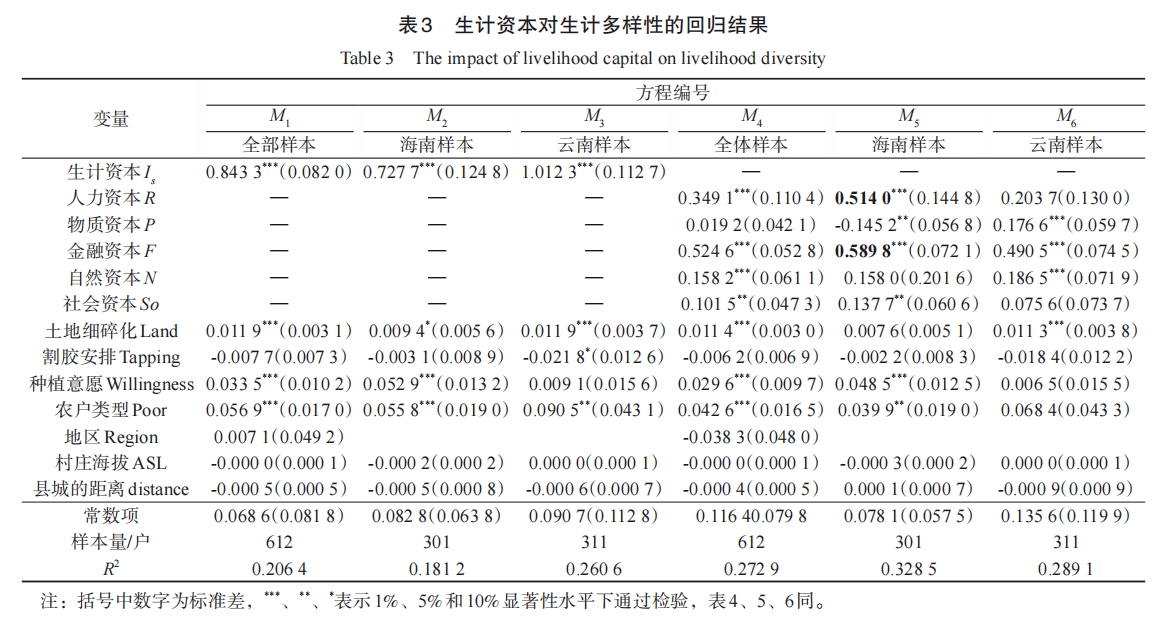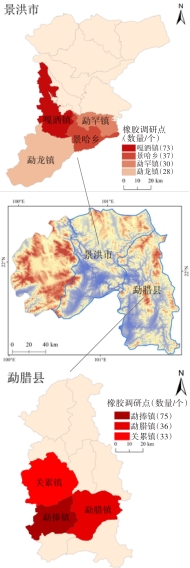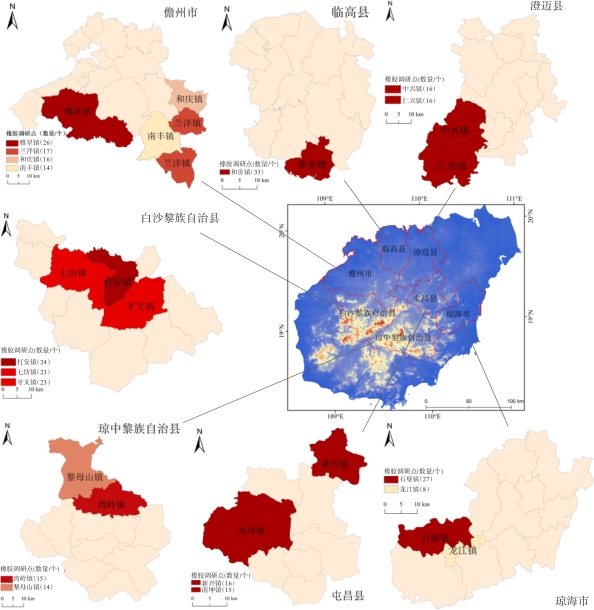

基于生计资本的农户可持续生计研究——以滇琼天然橡胶主产区为例
|
伍薇(1988—),女,广东台山人,助理研究员,硕士,主要研究方向为产业经济与风险管理等,(E-mail)wuwei.vivi@163.com; |
收稿日期: 2023-03-03
修回日期: 2023-08-19
网络出版日期: 2024-04-10
基金资助
海南省自然科学基金项目“全面实施乡村振兴战略背景下海南省橡胶种植户家庭可持续生计发展研究”(721QN339)
海南省自然科学基金“海南省农业绿色发展评价及影响因素研究”(722MS140)
中国热带农业科学院“揭榜挂帅”项目“自贸港建设背景下海南重要热带作物(橡胶树、槟榔树、椰子树)全产业链发展策略研究”(1630022022004)
Research on the Sustainable Livelihoods of Rural Households Based on Livelihood Capital: Evidence from the Natural Rubber Production Area in Hainan and Yunnan Provinces
Received date: 2023-03-03
Revised date: 2023-08-19
Online published: 2024-04-10
运用海南和云南橡胶主产区615个种植户的调查数据,测算了农户生计资本水平,设计了生计活动多样性指数和家庭收入多元化指数,通过多元线性回归模型和中介效应模型,探讨了生计资本配置对农户可持续生计的影响机制。研究发现:1)农户生计资本积累有助于丰富农户家庭生计活动和收入来源结构,尤其是金融资本积累有助于提升农户生计活动多样性水平;不同生计资本结构对农户生计结果的影响存在地域性差异;自然资本禀赋对海南产区的收入多元化水平有显著推动作用,但在云南产区却可能存在“诅咒”效应。2)地域差异、生产决策和农户特性对可持续生计有重要影响。村庄所处的海拔高、距县城距离远对农户开展多样化生计构成挑战;割胶生产规律固化虽然可能会削弱农户其他生产经营活动,但由于其劳动力调整灵活性强,可更好地稳定家庭收入;土地细碎化具有多元化生计的效果,但不一定有收入效应;虽然贫困户身份可帮助农户获得相关政策的支持,但增强生计能力才是实现可持续生计的关键所在。3)生计资本对生计活动和家庭收入的影响存在中介效应。生计资本对生计多样性的促进作用,有52.70%是通过提高生计资本统筹能力实现的,家庭就业策略优化有助于增强生计资本对收入多元化的促进作用,中介效应达30.52%。最后,建议通过提高农户家庭生计资本统筹能力、加强生计能力建设、扩展就业信息渠道等来增强农户生计综合能力。

伍薇 , 刘锐金 , 何长辉 , 杨琳 , 占达儒 . 基于生计资本的农户可持续生计研究——以滇琼天然橡胶主产区为例[J]. 热带地理, 2024 , 44(4) : 746 -760 . DOI: 10.13284/j.cnki.rddl.003859
Livelihood capital is the core element of sustainable livelihood development for rural households. Based on the survey data of 615 growers in the main rubber-producing areas of Hainan and Yunnan province, this paper constructs an evaluation system of rubber growers' livelihood capital within the sustainable livelihood analysis framework and calculates key indicators, such as farmers' livelihood capital index, livelihood activity diversity index, and household income diversity index. The multiple regression model and the mediating effect model are used to explore the influence mechanism of livelihood capital on the sustainable livelihood of rural households. The following three conclusions are drawn: (1) The accumulation of livelihood capital of rural households is conducive to enriching the structure of household livelihood activities and income sources, especially the accumulation of financial capital, which is more likely to improve the diversity of household livelihood activities. Regional differences exist in the impact of livelihood capital structures on rural household livelihood outcomes. Natural capital endowment has a significant effect on the income diversification level in Hainan, but there may be a "curse" effect in Yunnan. (2) Geographical characteristics, production decisions, and farming household characteristics significantly impact sustainable livelihoods. The altitude of the village and the distance from the county seat pose certain challenges for farmers in diversifying their livelihoods. Although the law of rubber tapping production may weaken farmers' production and business activities, it can better stabilize farmers' incomes owing to its strong flexibility in labor arrangements, which may be beneficial for diversifying livelihoods; however, it does not necessarily lead to diversified incomes. While the characteristics of poor households can help rural households gain policy support, building capacity is the key to achieving a sustainable livelihood. (3) There are intermediary effects of livelihood capital on livelihood activities and household income, but the mechanisms of action are different. For the diversity of farmers' livelihoods, 52.70% of the catalytic effect of livelihood capital is achieved by improving the ability to integrate livelihood capital. Optimizing household employment strategies contributed to the promotion of livelihood capital on the income diversification index, with a mediating effect of 30.52%. The main contribution of this study is to clarify how livelihood capital can achieve the goal of diversifying household livelihood activities and income by coordinating livelihood capacity and employment strategies. Therefore, to enhance the comprehensive livelihood capacity of rural households, the coordination capacity of livelihood capital, livelihood capacity building should be enhanced, and employment information channels should be expanded.

图2 云南西双版纳傣族自治州(a)和海南岛(b)两大调查区域及橡胶调研点分布Fig.2 Distribution of two major survey areas and rubber research sites in |
| a) | b) |
|---|---|
 |  |
| |
Xishuangbanna Dai Autonomous Prefecture,Yunnan(a) and Hainan Island(b) |
表1 橡胶种植户生计资本评价指标体系Table 1 Evaluation index system of livelihood capital of rubber growers |
| 一级指标 | 二级指标 | 赋值依据 | υij | ωi |
|---|---|---|---|---|
| 人力资本(R) | 家庭劳动能力(R 11) | 综合考察农户的年龄和健康状况,按照18~60岁、60岁以上、15~17岁分别赋值1、0.5、0.3,健康状况按很好、好、一般、不太好、很不好分别赋值1、0.75、0.5、0.25和0,根据年龄赋值×健康赋值计算家庭成员劳动能力,并加总得出家庭综合劳动能力。 | 0.341 7 | 0.173 5 |
| 成年劳动力受教育 程度(R 12) | 按照成年劳动力文化程度,大专及以上、高中、初中、小学、小学以下依次赋值1、0.8、0.6、0.4、0.2。 | 0.340 6 | ||
| 非农劳动力技能 水平(R 13) | 根据成年劳动力担任村干部、有务农以外技能、公务员身份、户口迁出等指标,回答“是”,则赋值0.25,再进行加总。 | 0.317 7 | ||
| 物质资本 (P) | 住房结构(P 11) | 楼房且2层及以上、在城镇买房=1,楼房仅为1层=0.75,平房=0.5,简易房、茅草房、土胚房=0.25,无房或租房=0。 | 0.206 0 | 0.286 3 |
| 房屋新旧程度(P 12) | 建房或修缮年份2010—2019年=1,2000—2009年=0.75,1990—1999年=0.5,1980—1989年=0.25,1980年以前建的房屋=0。 | 0.207 7 | ||
| 房屋面积(P 13) | 按实际平方数(m2)计算 | 0.204 8 | ||
| 互联网接入和 使用(P 14) | 接入网线赋值0.5,网售农产品和网购各赋值0.25,再累加。 | 0.202 3 | ||
| 轿车或者货车 拥有量(P 15) | 已购置且作为日常交通使用=1,已购置但作为运输等业务用途=0.5,未购置或曾购置但已出售或报废=0。 | 0.179 3 | ||
| 金融资本 (F) | 贷款获取能力(F 11) | 新近一次信用贷款金额 | 0.188 0 | 0.270 2 |
| 借钱渠道选择(F 12) | 选择银行=1,亲戚/朋友=0.75,父母子女=0.5,民间借贷或其他=0.25,未选择=0。 | 0.207 7 | ||
| 政府补贴(F 13) | 主要有耕地地力保护补贴、生态补助等,部分地区还有割胶补贴等,剔除危房改造补助等一次性大额补贴。 | 0.183 2 | ||
| 家庭内部金融支持(F 14) | 有储蓄且有外出打工支持=1,有外出打工支持=0.75,有储蓄且有外出打工但不支持=0.5,有储蓄但无外出打工=0.25,无储蓄且无外出打工=0。 | 0.205 7 | ||
| 家庭收入(F 15) | 2018年家庭实际收入 | 0.215 4 | ||
| 社会资本 (S) | 与村民的交流频率(So 11) | 非常多=1,比较多=0.75,一般=0.5,比较少=0.25,几乎没有=0。 | 0.376 3 | 0.156 4 |
| 人情礼金支出(So 12) | 人情交往的金钱投入,存在一定负面效应,但总体上体现农户家庭的社会交往面。 | 0.348 9 | ||
| 参与合作社(So 13) | 家庭成员参与合作社且管理=1,骨干或核心社员=0.666,普通会员0.333,未参与=0。 | 0.274 8 | ||
| 自然资本 (N) | 劳动力平均土地 面积(N 11) | 家庭农用地面积除以劳动力数量。 | 0.500 5 | 0.113 6 |
| 橡胶园面积(N 12) | 按实际面积,包含购买且未到期的胶园。 | 0.499 5 |
表2 生计可持续发展的变量设计Table 2 Variables for identifying factors influencing livelihood sustainability |
| 变量 | 指标 | 内容 |
|---|---|---|
| 被解释 变量 | Y 1:生计多样性指数Ls | 根据 |
| Y 2:收入多元化指数Si | 根据 | |
| 核心 解释 变量 | X 1:生计资本综合指数Is | 根据 |
| X 2:人力资本H | 根据各项生计资本评价 指标的分项权重和 标准化值计算而得,详见 | |
| X 3:物质资本P | ||
| X 4:自然资本N | ||
| X 5:社会资本So | ||
| X 6:金融资本F | ||
| 中介 变量 | K 1:就业策略Employ K 2:生计资本统筹能力Ds | 1=纯农;2=一兼户;3=二兼户;4=非农 |
| 根据 | ||
| 控制 变量 | Z 1:土地细碎化Land | 种植户胶园地块数量 |
| Z 2:农户类型Poor | 1=贫困户;0=一般户 | |
| Z 3:割胶生产安排Tapping | 1=弃割或其他;2=间断性割胶; 3=部分割胶;4=正常割胶 | |
| Z 4:种植意愿Willingness | 1=不愿意;2=没办法,不割胶没出路;3=愿意割胶 | |
| Z 5:地区Region | 1=海南;0=云南 | |
| Z 6:村庄海拔ASL | 调研村庄所处的海拔高度 | |
| Z 7:县城的距离distance | 调研村庄距离县城的距离 |
表3 生计资本对生计多样性的回归结果Table 3 The impact of livelihood capital on livelihood diversity |
| 变量 | 方程编号 | |||||
|---|---|---|---|---|---|---|
| M 1 | M 2 | M 3 | M 4 | M 5 | M 6 | |
| 全部样本 | 海南样本 | 云南样本 | 全体样本 | 海南样本 | 云南样本 | |
| 生计资本Is | 0.843 3***(0.082 0) | 0.727 7***(0.124 8) | 1.012 3***(0.112 7) | — | — | — |
| 人力资本R | — | — | — | 0.349 1***(0.110 4) | 0.514 0 ***(0.144 8) | 0.203 7(0.130 0) |
| 物质资本P | — | — | — | 0.019 2(0.042 1) | -0.145 2**(0.056 8) | 0.176 6***(0.059 7) |
| 金融资本F | — | — | — | 0.524 6***(0.052 8) | 0.589 8 ***(0.072 1) | 0.490 5***(0.074 5) |
| 自然资本N | — | — | — | 0.158 2***(0.061 1) | 0.158 0(0.201 6) | 0.186 5***(0.071 9) |
| 社会资本So | — | — | — | 0.101 5**(0.047 3) | 0.137 7**(0.060 6) | 0.075 6(0.073 7) |
| 土地细碎化Land | 0.011 9***(0.003 1) | 0.009 4*(0.005 6) | 0.011 9***(0.003 7) | 0.011 4***(0.003 0) | 0.007 6(0.005 1) | 0.011 3***(0.003 8) |
| 割胶安排Tapping | -0.007 7(0.007 3) | -0.003 1(0.008 9) | -0.021 8*(0.012 6) | -0.006 2(0.006 9) | -0.002 2(0.008 3) | -0.018 4(0.012 2) |
| 种植意愿Willingness | 0.033 5***(0.010 2) | 0.052 9***(0.013 2) | 0.009 1(0.015 6) | 0.029 6***(0.009 7) | 0.048 5***(0.012 5) | 0.006 5(0.015 5) |
| 农户类型Poor | 0.056 9***(0.017 0) | 0.055 8***(0.019 0) | 0.090 5**(0.043 1) | 0.042 6***(0.016 5) | 0.039 9**(0.019 0) | 0.068 4(0.043 3) |
| 地区Region | 0.007 1(0.049 2) | -0.038 3(0.048 0) | ||||
| 村庄海拔ASL | -0.000 0(0.000 1) | -0.000 2(0.000 2) | 0.000 0(0.000 1) | -0.000 0(0.000 1) | -0.000 3(0.000 2) | 0.000 0(0.000 1) |
| 县城的距离distance | -0.000 5(0.000 5) | -0.000 5(0.000 8) | -0.000 6(0.000 7) | -0.000 4(0.000 5) | 0.000 1(0.000 7) | -0.000 9(0.000 9) |
| 常数项 | 0.068 6(0.081 8) | 0.082 8(0.063 8) | 0.090 7(0.112 8) | 0.116 40.079 8 | 0.078 1(0.057 5) | 0.135 6(0.119 9) |
| 样本量/户 | 612 | 301 | 311 | 612 | 301 | 311 |
| R 2 | 0.206 4 | 0.181 2 | 0.260 6 | 0.272 9 | 0.328 5 | 0.289 1 |
|
表4 海南和云南橡胶种植户的生计资本比较分析Table 4 Comparative analysis of livelihood capitals of rubber growers in Hainan and Yunnan |
| 地区 | 人力资本 | 物质资本 | 金融资本 | 社会资本 | 自然资本 | 生计资本 |
|---|---|---|---|---|---|---|
| 均值差 | -0.002 6 | -0.164 1*** | 0.040 8*** | -0.001 1 | -0.070 3*** | -0.044 6*** |
| 海南 | 0.136 1 | 0.438 7 | 0.268 1 | 0.271 0 | 0.075 6 | 0.272 6 |
| 云南 | 0.138 7 | 0.602 8 | 0.227 3 | 0.272 1 | 0.145 9 | 0.317 2 |
表5 生计资本对收入多元化的回归结果Table 5 The impact of livelihood capital on income diversification |
| 变量 | 方程编号 | |||
|---|---|---|---|---|
| M 7 | M 8 | M 9 | M 10 | |
| 全部样本 | 全部样本 | 海南样本 | 云南样本 | |
| 生计资本Is | 0.286 8***(0.105 2) | — | — | — |
| 人力资本R | — | 0.329 6***(0.111 0) | 0.062 9(0.168 0) | 0.411 8**(0.163 3) |
| 物质资本P | — | 0.052 8(0.053 2) | -0.010 5(0.078 9) | 0.039 8(0.072 4) |
| 金融资本F | — | 0.170 9***(0.066 5) | 0.187 9*(0.097 0) | 0.135 5(0.092 9) |
| 自然资本N | — | -0.256 9***(0.079 4) | 0.520 9***(0.197 0) | -0.347 9***(0.093 0) |
| 社会资本So | — | 0.017 0(0.061 4) | -0.005 2(0.082 3) | 0.024 6(0.088 0) |
| 土地细碎化Land | -0.003 5(0.003 7) | -0.000 5(0.003 7) | 0.003 7(0.006 6) | -0.002 8(0.004 2) |
| 割胶安排Tapping | 0.039 5***(0.008 7) | 0.038 3***(0.009 0) | 0.053 5***(0.010 4) | 0.015 2(0.016 1) |
| 种植意愿Willingness | 0.008 1(0.012 1) | 0.010 9(0.012 0) | -0.023 7(0.015 5) | 0.042 6**(0.017 0) |
| 农户类型Poor | 0.078 9***(0.022 6) | 0.074 8***(0.022 9) | 0.092 0***(0.025 7) | -0.056 3(0.060 8) |
| 地区Region | -0.040 9(0.060 3) | -0.024 7(0.061 0) | ||
| 村庄海拔ASL | -0.000 1(0.000 1) | -0.000 1(0.000 1) | 0.000 1(0.000 1) | -0.000 3 **(0.000 1) |
| 县城的距离distance | -0.001 7*** (0.000 6) | -0.000 8(0.000 7) | 0.000 7(0.000 9) | -0.002 4**(0.001 1) |
| 常数项 | 0.261 3***(0.097 5) | 0.181 2(0.097 6) | 0.101 4(0.074 5) | 0.436 9***(0.145 5) |
| 样本量/户 | 612 | 612 | 301 | 311 |
| R 2 | 0.087 6 | 0.115 0 | 0.183 9 | 0.161 0 |
表6 中介效应回归结果Table 6 The regression results of mediation effect |
| 变量 | 生计多样性M 11 | 收入多元化M 12 | |||||
|---|---|---|---|---|---|---|---|
| (1) | (2) | (3) | (4) | (5) | (6) | ||
| 被解释变量 | 生计多样性 指数Ls | 生计资本 统筹能力Ds | 生计多样性 指数Ls | 收入多元化 指数Si | 就业策略Employ | 收入多元化 指数Si | |
| 生计资本Is | 0.843 3***(0.087 7) | 0.864 3***(0.019 8) | 0.398 9**(0.177 9) | 0.286 8***(0.106 8) | 0.858 3*(0.452 6) | 0.199 2**(0.096 7) | |
| 就业策略Employ | — | — | — | — | — | 0.102 0***(0.008 7) | |
| 生计资本统筹能力Ds | — | — | 0.514 2***(0.180 4) | — | — | — | |
| 控制变量 | 是 | 是 | 是 | 是 | 是 | 是 | |
| 常数项 | 是 | 是 | 是 | 是 | 是 | 是 | |
| 样本量/户 | 612 | 612 | 612 | 612 | 612 | 612 | |
| Adj R 2 | 0.195 9 | 0.795 8 | 0.205 4 | 0.075 5 | 0.269 3 | 0.246 9 | |
| Sobel检验 | Z=2.86***,中介效应显著 | Z=1.87 2*中介效应显著 | |||||
| 中介效应 | 中介效应=0.444 4 | 中介效应=0.087 5* | |||||
| 中介效应/总效应=52.70% | 中介效应/总效应=30.52% | ||||||
表7 中介效应的稳健性检验Table 7 Test for robustness of mediation effects |
| 作用路径 | 中介效应 | 标准差 | 下限 | 上限 | 检验结果 |
|---|---|---|---|---|---|
| H2生计资本→生计资本统筹能力→生计多样性 | 0.444 4*** | 0.006 5 | 0.126 6 | 0.767 7 | 成立 |
| H4生计资本→就业策略→收入多元化 | 0.087 5* | -0.000 3 | 0.002 0 | 0.194 6 | 成立 |

伍 薇:论文撰写;
刘锐金:论文指导与修改;
何长辉:参与论文讨论及协助修改;
杨 琳:资料搜集与梳理;
占达儒:数据整理与绘图。
|
安士伟,樊新生. 2018. 基于收入源的农户生计策略及其影响因素分析——以河南省为例. 经济经纬,35(1):29-34.
An Shiwei and Fan Xinsheng. 2018. Analysis of Farmers' Livelihood Strategy and its Influencing Factors Based on Income Source: A Case Study of Henan Province. Economic Survey, 35(1): 29-34.
|
|
Barrett B C, Bezuneh M, and Aboud A. 2001. Income Diversification, Poverty Traps and Policy Shocks in Gote D'Ivoire and Kenya. Food Policy, 26(4): 367-384.
|
|
DFID. 1999. Sustainable Livelihoods Guidance Sheets. London: Department for International Development.
|
|
杜翼. 2018. 人力资本的禀赋与农户生计多样性研究. 山西农经,(18):41-42.
Du Yi. 2018. Research on the Endowment of Human Capital and the Diversity of Farmers' Livelihoods. Shanxi Agricultural Economy, (18): 41-42.
|
|
杜国明,盖兆雪,王洪彦. 2021. 中国耕地细碎化的理论解析与研究框架. 地球科学与环境学报,43(6):997-1008.
Du Guoming, Gai Zhaoxue, and Wang Hongyan. 2021. Theoretical Explanation and Research Framework of Cultivated-Land Fragmentation in China. Journal of Earth Sciences and Environment, 43(6): 997-1008.
|
|
Fu Yongneng, Brookfield H, Guo Huijun, Chen Jin, Chen Aiguo, and Cui Jingyun. 2009. Smallholder Rubber Plantation Expansion and Its Impact on Local Livelihoods, Land Use and Agrobiodiversity, A Case Study from Daka, Xishuangbanna, Southwestern China. International Journal of Sustainable Development & World Ecology, 16(1): 22-29.
|
|
耿言虎. 2014. 自然的过度资本化及其生态后果——云南“橡胶村”案例研究. 河海大学学报(哲学社会科学版),16(2):31-36,91.
Geng Yanhu. 2014. Excessive Capitalization of Nature and Ecological Consequence: A Case Study of Rubber Village in Yunnan Province. Journal of Hohai University(Philosophy and Social Sciences), 16(2): 31-36, 91.
|
|
何长辉,莫业勇. 2017. 价格低迷背景下橡胶种植农户生产行为调查分析. 中国热带农业,(6):20-27.
He Changhui and Mo Yeyong. 2017. Survey and Analysis of Production Behavior of Rubber Farmers under the Background of Low Prices. China Tropical Agriculture, (6): 20-27.
|
|
黄志刚,黎洁,王静. 2021. 贫困区农户生计资本组合对收入影响的优化效应分析——基于陕西778份农户调查数据. 农业技术经济,(7):79-91.
Huang Zhigang, Li Jie, and Wang Jing. 2021. Optimization Analysis of the Combination Effect of Livelihood Capitals on Family Income in Poverty Areas: Based on 778 Rural Households' Survey Data in Shaanxi Province, China. Journal of Agrotechnical Economics, (7): 79-91.
|
|
蒋维,杨新军,王俊. 2014. 基于农户尺度的黄土高原农村社会——生态系统体制转换. 干旱区资源与环境,28(11):37-41.
Jiang Wei, Yang Xinjun, and Wang Jun. 2014. Shift of Rural Social-Ecological System Regimes in Loess Plateau Based on Rural Household Dimension. Journal of Arid Land Resources and Environment, 28 (11) : 37-41.
|
|
Khamphone B and Sato N. 2011. Effectiveness of Rubber Plantation on Villagers' Livelihood Improvement in the Northern Part of Laos. Journal Faculty of Agriculture Kyushu University, 56(1): 185-191.
|
|
Lazar M K, Dwyer M, and Wong G. 2016. Assessment of Governance Mechanisms, Livelihood Outcomes and Incentive Instruments for Green Rubber in Myanmar. (2016-08-02) [2019-06-11]. http://www.cifor.org/publications/pdf_files/WPapers/WP207CIFOR.pdf.
|
|
李达,张绍文. 2020a. 橡胶主产区农户“橡胶依赖”及其影响因素——基于西双版纳612份胶农调查数据. 热带地理,40(6):1085-1093.
Li Da and Zhang Shaowen. 2020a. Farms' "Rubber Dependence" and Influencing Factors in Major Rubber Producing Areas: Empirical Evidence from 612 Farm Households in Xishuangbanna. Tropical Geography, 40(6): 1085-1093.
|
|
李达,张绍文. 2020b. 天然橡胶产业发展政策分析:红线与红利. 林业经济问题,40(2):208-215.
Li Da and Zhang Shaowen. 2020b. Natural Rubber Industry Development Policy Analysis: Borders and Bonus. Issues of Forestry Economics, 40(2): 208-215.
|
|
李功奎,钟甫宁. 2006. 农地细碎化、劳动力利用与农民收入——基于江苏省经济欠发达地区的实证研究. 中国农村经济,(4):42-48.
Li Gongkui and Zhong Puning. 2006. Agricultural Land Fragmentation, Labor Utilization and Farmers' Income: an Empirical Study Based on Economically Underdeveloped Areas in Jiangsu Province. Chinese Rural Economy, (4): 42-48.
|
|
刘俊,张恒锦,金朦朦,李宁馨. 2019. 旅游地农户生计资本评估与生计策略选择——以海螺沟景区为例. 自然资源学报,34(8):1735-1747.
Liu Jun, Zhang Hengjin, Jin Mengmeng, and Li Ningxin. 2019. The Evaluation of Households' Livelihood Capital and Their Livelihood Strategies in the Tourist Area: A Case Study in Hailuogou Scenic Area. Journal of Natural Resources, 34(8): 1735-1747.
|
|
Li Mengping, Huo Xuexi, Peng Changhui, Qiu Huanguang, Shangguan Zhouping, Chang Cheng, and Huai Jianjun. 2017. Complementary Livelihood Capital as a Means to Enhance Adaptive Capacity: A Case of the Loess Plateau, China. Global Environmental Change, 47: 143-152.
|
|
刘七军,曲纬,李昭楠. 2011. 耕地细碎化对干旱绿洲区作物生产和农户收入影响效应调查分析——以甘肃省民乐县为例. 干旱地区农业研究,29(3):191-198,185.
Liu Qijun, Qu Wei, and Li Shaonan. 2011. A Survey and Analysis of the Impacts of Land Fragmentation on Crops Production and Farmers' Income in Arid Oasis Regions: A Case from Minle County of Gansu Province. Agricultural Research in the Arid Areas, 29(3): 191-198, 185.
|
|
刘锐金,伍薇,何长辉. 2015. 橡胶种植户参与价格稳定基金的影响因素. 林业经济问题,35(4):330-337.
Liu Ruijin, Wu Wei, and He Changhui. 2015. Study on Willingness of Rubber Farmers to Participate in Price Stability Fund. Issues of Forestry Economics, 35(4): 330-337.
|
|
刘锐金,何长辉,伍薇. 2018a. 海南省民营橡胶生产成本探析. 中国物价,(9):71-74.
Liu Ruijin, He Changhui, and Wu Wei. 2018a. Analysis of Private Rubber Production Costs in Hainan Province. China Price, (9): 71-74.
|
|
刘锐金,伍薇,何长辉. 2018b. 橡胶种植户对价格低迷的反应——意愿表达与行为选择. 林业经济问题,38(4):55-63.
Liu Ruijin, Wu Wei, and He Changhui. 2018b. Study on the Response of Rubber Growers to Low Prices: Willingness Expression and Behavior Choice. Issues of Forestry Economics, 38(4): 55-63.
|
|
刘锐金,黄华孙. 2021a. “十四五”时期推动天然橡胶产业健康发展的思考. 中国热带农业,(4):5-12.
Liu Ruijin and Huang Huasun. 2021a. Thoughts on Promoting the Sound Development of Natural Rubber Industry during the 14th Five-year Plan Period. China Tropical Agriculture, (4): 5-12.
|
|
刘锐金,何长辉,伍薇. 2021b. 橡胶种植户的农业支持政策偏好分析. 热带农业科学,41(6):105-113.
Liu Ruijin, He Changhui, and Wu Wei. 2021b. Analysis of Rubber Growers' Preference for Support Policy. Chinese Journal of Tropical Agriculture, 41(6): 105-113.
|
|
李雪萍,魏爱春. 2020. 摆动型生计:生计能力视域下的生存策略选择——以重庆市M镇易地扶贫搬迁安置点为例. 吉首大学学报(社会科学版),41(4):65-74.
Li Xueping and Wei Aichun. 2020. Livelihood of Pendulum Mobility: The Choice of Survival Strategies from the Perspective of Livelihood Capacity: A Case Study of the Relocation Site of Poverty Alleviation in M Town of Chongqing. Journal of Jishou University (Social Sciences), 41(4): 65-74.
|
|
刘永茂,李树茁. 2017. 农户生计多样性发展阶段研究——基于脆弱性与适应性维度. 中国人口·资源与环境,27(7):147-156.
Liu YongMao and Li Shuzhuo. 2017. Study on the Development Stages of Household Livelihood Diversification. China Population, Resources and Environment, 27(7): 147-156.
|
|
闵师,王晓兵,白军飞,黄季焜. 2017. 预期价格变动对农户生产行为调整的非对称影响——基于西双版纳胶农调查分析. 农业现代化研究,38(3):475-483.
Min Shi, Wang Xiaobin, Bai Junfei, and Huang Jikun. 2017. Asymmetric Response of Farmers’ Production Adjustment to the Expected Price Volatility: Evidence from Smallholder Rubber Farmers in Xishuangbanna. Research of Agricultural Modernization, 38(3): 475-483.
|
|
马国璇,周忠发,朱昌丽,陈全,但雨生,吴跃. 2020. 农户生计资本与生计稳定性耦合协调分析——以花江示范区峡谷村为例. 水土保持研究,27(3):230-237.
Man Guoxuan, Zhou Zhongfa, Zhu Changli, Chen Quan, Dan Yusheng, and Wu Yue. 2020. Analysis on Coupling Coordination of Livelihood Capital and Livelihood Stability of Farmers: A Case of the Xiaogu Village in Huajiang Demonstration Area. Research of Soil and Water Conservation, 27(3): 230-237.
|
|
蒙吉军,艾木入拉,刘洋,向芸芸. 2013. 农牧户可持续生计资产与生计策略的关系研究——以鄂尔多斯市乌审旗为例. 北京大学学报(自然科学版),49(2):321-328.
Meng Jijun, Ai Murula, Liu Yang, and Xiang Yunyun. 2013. Study on Relationship between Livelihood Capital and Livelihood Strategy of Farming and Grazing Households: A Case of Uxin Banner in Ordos. Acta Scientiarum Naturalium Universitatis Pekinensis, 49(2): 321-328.
|
|
秦伟. 2008. 可持续发展视角下的农户个体选择行为——以西双版纳橡胶种植业为例. 云南社会科学,(5):117-122.
Qin Wei. 2008. Individual Choice Behavior of Farmers from the Perspective of Sustainable Development: A Case Study of Xishuangbanna Rubber Plantation. Social Sciences in Yunnan, (5): 117-122.
|
|
Sharp K. 2003. Measuring Destitution: Integrating Qualitative and Quantitative Approaches in the Analysis of Survey Data. Brighton: IDS, Working Paper Series, 217.
|
|
苏芳. 2005. 可持续生计:理论、方法与应用. 北京:中国社会科学出版社,24-33.
Su Fang. 2005. Sustainable Livelihood: Theories, Methods and Applications. Beijing: China Social Sciences Press, 24-33.
|
|
孙特生,胡晓慧. 2018. 基于农牧民生计资本的干旱区草地适应性管理——以准噶尔北部的富蕰县为例. 自然资源学报,33(5):761-774.
Sun Tesheng, and Hu Xiaohui. 2018. Grassland Adaptive Management in Arid Region Based on Livelihood Capitals of Peasants and Herdsmen: A Case Study of Fuyun County in the North of Junggar Basin, China. Journal of Natural Resources, 33(5): 761-774.
|
|
涂丽. 2018. 生计资本、生计指数与农户生计策略——基于CLDS家户数据的实证分析. 农村经济,(8):76-83.
Tu Li. 2018. Livelihood Capital, Livelihood Index and Farmers' Livelihood Strategies: An Empirical Analysis based on CLDS Household Data. Rural Economy, (8): 76-83.
|
|
魏爱春,李雪萍. 2020. 类型比较与抗逆力建设的内部差异性研究——以渝东M镇105户易地扶贫搬迁移民为例. 中南大学学报(社会科学版),26(5):177-189.
Wei Aichun and Li Xueping. 2020. The Study on Type Comparison and Internal Differences of Resilience Construction: Taking 105 Migrants in Inhospitable Areas of M Town in Eastern Chongqing as an Example. Journal of Central South University (Social Sciences), 26(5): 177-189.
|
|
王丹丹,甘淑,张超,孙冠华. 2013. 不同地形特征下云南沿边村寨农户生计资本研究. 云南地理环境研究,25(6):41-47.
Wang Dandan, Gan Shu, Zhang Chao, and Sun Guanhua. 2013. Study for Farmers' Livelihood Capitals in Border Villages of Yunnan Province Which Have Different Topographic features. Yunnan Geographic Environment Research, 25(6): 41-47.
|
|
王娟,吴海涛,丁士军. 2014. 山区农户最优生计策略选择分析——基于滇西南农户的调查. 农业技术经济,(9):97-107.
Wang Juan, Wu Haitao, and Ding Shijun. 2014. Analysis of Optimal Livelihood Strategy Choices of Rural Households in Mountainous Areas: Based on the Survey of Farmers in Southwest Yunnan. Journal of Agrotechnical Economics, (9): 97-107.
|
|
王君涵,李文,冷淦潇,仇焕广. 2020. 易地扶贫搬迁对贫困户生计资本和生计策略的影响. 中国人口·资源与环境,30(10):143-153.
Wang Junhan, Li Wen, Leng Ganxiao, and Qiu Huanuang. 2020. Impact of Poverty Alleviation Relocation on Livelihood Capital and Livelihood Strategy of Poor Households. China Population, Resources and Environment, 30(10): 143-153.
|
|
王群勇,张乃丹. 2022. 社会网络与收入多样性:非正规借贷和就业的中介作用. 农业技术经济,(4):50-66.
Wang Qunyong and Zhang Naidan. 2022. Social Network and Income Diversification: Mediating Role of Informal Credit and Employment. Journal of Agrotechnical Economics, (4): 50-66.
|
|
王淑佳,孔伟,任亮,治丹丹,戴彬婷. 2021. 国内耦合协调度模型的误区及修正. 自然资源学报,36(3):793-810.
Wang Shujia, Kong Wei, Ren Liang, Zhi Dandan, and Dai Binting. 2021. Research on Misuses and Modification of Coupling Coordination Degree Model in China. Journal of Natural Resources, 36(3): 793-810.
|
|
Xi Jiao, Marrieve P, and Zena W S. 2017. Livelihood Strategies and Dynamics in Rural Cambodia. World Development, 97: 266-278.
|
|
许庆,田士超,邵挺,汪学军. 2007. 土地细碎化与农民收入:来自中国的实证研究. 农业技术经济,(6):67-72.
Xu Qing, Tian Shichao, Shao Ting, and Wang Xuejun. 2007. Land Fragmentation and Farmers' Income: An Empirical Study from China. Journal of Agrotechnical Economics, (6): 67-72.
|
|
徐戈,陆迁,姜雅莉. 2019. 社会资本、收入多样化与农户贫困脆弱性. 中国人口·资源与环境,29(2):123-133.
Xu Ge, Lu Qian, and Jiang Yali. 2019. Social Capital, Income Diversification and Households’ Poverty Vulnerability. China Population, Resources and Environment, 29(2): 123-133.
|
|
阎建忠,吴莹莹,张镱锂,周绍宾. 2009. 青藏高原东部样带农牧民生计的多样性. 地理学报,20(5):757-770.
Yan Jianzhong, Wu Yingying, Zhang Yili, and Zhou Shaobin. 2009. Livelihood Diversification of Farmers and Nomads of Eastern Transect in Tibetan Plateau. Journal of Geographical Sciences, 20(5): 757-770.
|
|
张家硕,周忠发,陈全,朱昌丽,马国璇. 2022. 典型喀斯特山区农户生计多样性与多维相对贫困的耦合关系. 山地学报,40(3):450-461.
Zhang Jiashuo, Zhou Zhongfa, Chen Quan, Zhu Changli, and Ma Guoxuan. 2022. Relationship between Livelihood Diversity and Multidimensional Relative Poverty of Farming Households in Typical Chinese Karst Mountains. Mountain Research, 40(3): 450-461.
|
|
赵宁宁,郭炎,李志刚,许红梅. 2021. 中部地区乡村生产要素协同转型的时空格局及影响因素——以湖南岳阳为例. 自然资源学报,36(12):3170-3185.
Zhao Ningning, Guo Yan, Li Zhigan, and Xu Hongmei. 2021. Spatio-Temporal Patterns and Influencing Factors of the Collaborative Transformation of Rural Production Factors in Central China: A Case Study of Yueyang, Hunan Province. Journal of Natural Resources, 36(12): 3170-3185.
|
|
张童,李兰英,孙玮倩,占菁,顾倩芸. 2022. 金融资本对林农生计策略的影响研究——基于浙江省山区农户的实证分析. 四川农业科技,(8):71-75.
Zhang Tong, Li Lanying, Sun Weiqian, Zhan Jing, and Gu Qianyun. 2022. Research on the Impact of Financial Capital on the Livelihood Strategies of Forest Farmers: An Empirical Analysis Based on the Rural Households in Mountainous Areas of Zhejiang Province. Sichuan Agricultural Science and Technology, (8): 71-75.
|
|
张尹君杰,卓建伟. 2008. 土地细碎化的正面与负面效应的双重论证——基于河北省农户固定观察点资料的实证研究. 江西农业大学学报(社会科学版),7(4):25-29.
Zhang yinjunjie and Zhuo Jianwei. 2008. Dual Demonstration of the Positive and Negative Effects of Land Fragmentation: An Empirical Study Based on the Data of Fixed Observation Points of Farmers in Hebei Province. Journal of Agro-Forestry Economics and Management, 7(4): 25-29.
|
|
钟真,黄斌,张德生. 2021. 长期低价影响下的胶农生产经营适应性研究——基于西双版纳傣族自治州植胶区的调查. 农业农村部管理干部学院学报,(1):33-40.
Zhong Zhen, Huang Bin, and Zhang Desheng. 2021. Study on the Adaptability of Natural Rubber Growers' Production and Operation under the Impact of Long-Term Low Prices: Based on the Investigation of Natural Rubber Planting Area in Xishuangbanna Dai Autonomous Prefecture. Journal of Administration and Management Institute of Ministry of Agriculture and Rural Affairs, (1): 33-40.
|
/
| 〈 |
|
〉 |